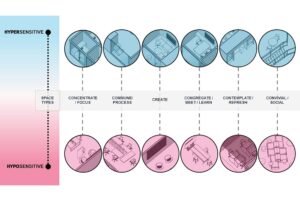
There is ever increasing acknowledgement of the need for diversity of thought within all spheres of society. When it comes to the workplace, understanding more about this topic and how people on the edges of the spectrum can be better supported within workplaces, will contribute to evolving organisations into more inclusive environments.
“Neurodiversity” refers to the natural range of variation in human neurocognition. It’s an umbrella term for people who aren’t neurotypical, and includes such conditions as autism spectrum disorder (ASD), attention deficit hyperactivity disorder (ADHD), dyslexia, dyspraxia (a neurologically based physical disorder) and Tourette syndrome, among others. Approximately 15-20 percent of people are “neurodivergent.”
– HoK report ‘Designing a neurodivergent workplace’ (1)
With approximately 15-20% of people, or 1 in 8 adults being neurodivergent (1), it is an issue that is extensively present in our society. While some people who are neurodivergent are expected to adapt their behaviour to their surroundings – reasons for this may be misinformation, stigma, or cultural and industry norms – others are encouraged to adapt their environment to better support their everyday activities. Viewing the built environment as a contributing enabler for better work and better learning, highlights the importance of understanding the impact of sound and the acoustic conditions of a room, on people with varied neurocognition. With this heightened understanding, acoustic design measures can be harnessed to create spaces with a variety of acoustic characteristics that match the varied needs of neurodivergents.
Aspects such as temperature, acoustics, lighting and colour all play a large role in the experiential quality of a space. With acoustics being particularly relevant to the work done at Ecophon, this article will focus on the aspect of sound in relation to neurodiversity, however also include the broader understanding presented through the lens of workplace design.
Why is neurodiversity so important to an Architecture and Design firm?
To unpack neurodiversity and design, I turned to Kay Sargent, Director of Workplace at HOK. HOK is one of the largest architecture and design firms in the USA and is present globally. Kay leads the workplace design team at HOK where they have recently released several reports (links at the end of this article) that cover trends affecting neurodiversity, as well as suggested design interventions for workplaces to better support neurodiverse employees.
In our conversation, Kay explained how the team at HOK first started researching this topic when a client asked them to advise on how to better accommodate employees who had ADHD within their workplace. After trawling extensively through the available literature, the HOK team realised that almost all the research centred on primary and secondary age school children, with very little that would inform a perspective on adult employees, or inform advise on how to design the workplace to better support someone with ADHD.
Early on, it became evident that this was a deeply personal issue for many, whether it be the majority of the HOK executive team who had neurodiverse family members, or audience members to early iterations of this topic who expressed their own or closely witnessed experiences of their neurodiverse friends, colleagues or family. The obligation to explore this topic further and also start to present design solutions was clear.
During this early process Kay, who advocates extensively for how space can have a powerful impact on individuals, felt compelled to acknowledge that if designers do not thoroughly understand certain factors – acoustics being one of these – poorly designed spaces will be the result, which can have a negative impact on end users, neurodivergents most of all.
Key facts on Neurodiversity
So, what is neurodiversity? It is a term that refers to the breadth of human neurocognitive functioning.
Everyone’s brains are wired differently, which results in each of us occupying a different position on the ‘neuro-spectrum’ – a continuum of neurotypical and neurodiverse brain wiring.
When defining aspects of neurodiversity, some people’s brains are wired to register more information, making them generally more sensitive to sensory stimulation (hypersensitive) and some are wired to ignore input or sensory information, making them less sensitive to their surrounding environment (hyposensitive). These are the two extremes that book-end the group in the middle, who are wired to accommodate a wider range of sensory input. When considering this diversity in relation to work, it is clear that people have very different experiences of the workplace or the built environment around them.
It is important to remember, as the HOK team phrased it:
“What is good for the extreme, is good for the mean.”
Neurodivergents can include people with ADHD, autism, Tourette syndrome, dyslexia, dyspraxia, and several other conditions. Being neurodivergent can have incredible advantages, with people able to do some things easily that others find much harder. Some examples of this can be creative thinking, pattern recognition, heightened memory, or being extremely focused. There is an increasing call for more diversity within workplaces with neurodiversity being one important aspect of this, contributing to creating an environment that would in turn create more representative products, services and policies for our society.
One may still wonder if this is just a niche topic, however, to reiterate that research predicts that 1 in 8 people are neurodiverse, with less than 50% of those affected aware of their own diagnosis. With this becoming an increasingly prevalent issue, one can argue that it is irresponsible, unsustainable and unkind to design a workplace without including interventions to accommodate an increasingly diverse set of employee needs.
Considering neurodiversity in the design of workplaces
Where do we even start with looking at the challenge of how to design workplaces that can enable and support a neurodiverse employee population?
“A move toward prevention-focused health frameworks, more individualized consumer needs, and the ability of data to inform the delivery of personalized healthcare services is transforming how people define the role of health in their lives. This will be supported by advances in human-centric, next-generation biology and information and communications technology (ICT) platforms that will shift services toward preventive behaviors and early interventions. Going forward, we can expect employers, healthcare providers and insurance companies to accommodate people’s specific preferences and needs. This likely will include a wide range of customized technologies and services for assisting neurodivergent staff at work and in their daily lives.”
HOK ‘Trends affecting Neurodiversity’ report
It is clear that the capability to deliver more individually suited services, experiences and environments is becoming increasingly possible and in turn increasingly expected. For employers to attract and retain neurodiverse talent, a variety of physical interventions and accompanying behaviour or policy related interventions will need to be in place. For the purposes of unpacking how sound and acoustics is relevant within this topic, the focus here is on interventions to the physical work environment. It is important, however, to acknowledge that many of the significant shifts that are needed to create a functioning and inclusive work environment have less to do with the position of walls, selection of work settings, quantity of acoustic absorption, colour of the walls etc – and much more to do with aspects such as hiring practises, greater flexibility in work hours and location, provision of assistive technology, and creation of greater empathy within teams. While the physical solutions are a crucial first step, the behaviour and policy considerations are what will amplify the effectiveness of a considerately designed space.
So, how can designers contribute to shaping workplaces that offer a wide range of choice with characteristics that better enable productive work for either hyper or hypo sensitive neurodivergents?

The HOK design team have defined 5 modalities of work:
– Concentrate / Focus
– Commune / Process
– Congregate / Meet / Learn
– Contemplate / Refresh
– Convivial / Social
One can easily situate varied work activities within one or a few of each of these types of spaces. For each of these modalities of space, a suggestion of how to best adapt the design of these spaces to support different needs is summarised in the image below.
For example, an environment for focus work for a hypersensitive person will be enclosed, provides both visual and acoustic privacy, toned down in design features, seated workstation and positioned away from high traffic areas. On the other end of the spectrum, a focus environment for a hyposensitive person would be sheltered but not enclosed, offer a seated or standing workstation, as well as a usable vertical service (white board or screen).
Take a look at the full report for further info.
Specific acoustic insights
While HOK have laid out some suggestions on how to consider acoustics in the designed solutions for the 6 modalities of work, I would like to add a few additional suggestions and insights:
- When it comes to sound, everyone across the spectrum is negatively affected by very high levels of noise and poor acoustic conditions. This is especially true when communication is necessary. In this regard, it is important to ensure that the sound pressure level can be kept to a comfortable level, by adding in adequate acoustic absorption, to any environment that will be used by more than a few people at any one time. This will improve the indoor experience of everyone, wherever they are positioned on the neurodiverse spectrum.
- Ensure that there is the correct ratio and placement of absorption, reflection and diffusion elements to ensure speech is clear in rooms where this is important. Again this is something that will benefit everyone.
- Silence is unsettling for most people. This reaction has its origin in the days when the human sense of hearing fulfilled an important survival function, and where silence was usually a sign that a predator was stalking its prey (you!). Uncomfortably high levels of sound should not happen regularly, however, neither should a work environments be totally silent.
- A workplace that offers a range of spaces is crucial to providing a level of choice that accommodates and supports diverse needs. Within this range of spaces, it is important to create spaces which are different in their acoustic qualities: i.e. ensure that a quiet room is actually acoustically private and acoustically quiet through good sound insulation and good absorption.
What else could be key to creating better environments that enable better work for a wider spectrum of the neurodiverse population?
How do we ensure, even within the very specific field of acoustics, this this industry is helping to enable a more inclusive, more diverse working world?
Further information can be found by accessing these HOK reports:
Designing a neurodiverse workplace
Trends affecting neurodiversity toward 2030

